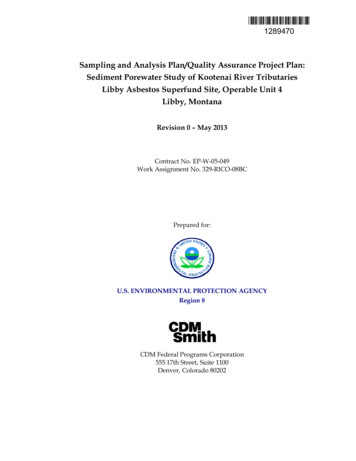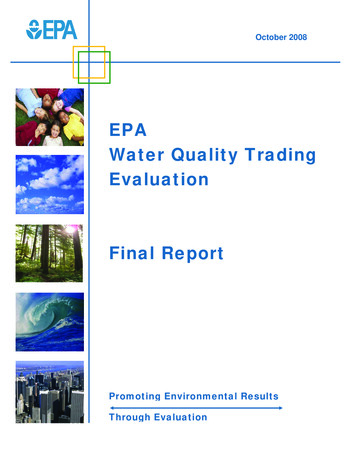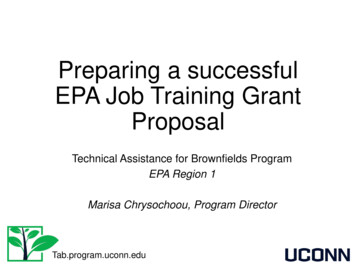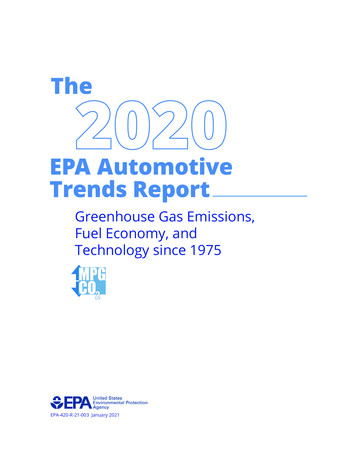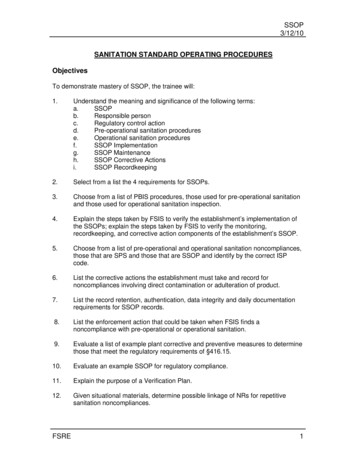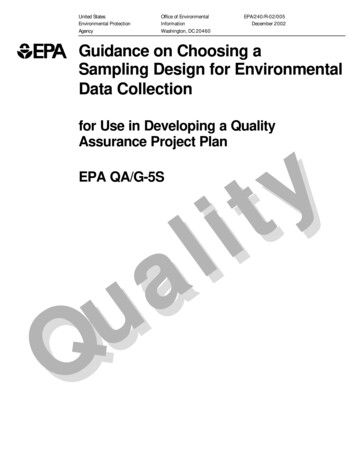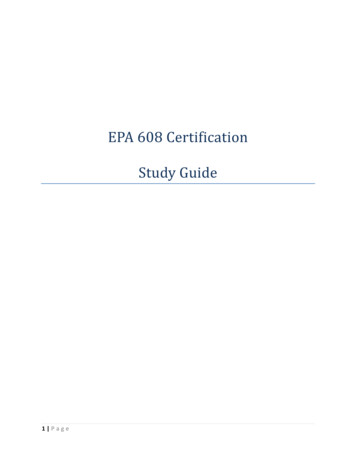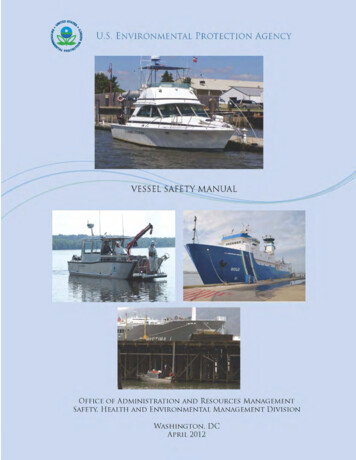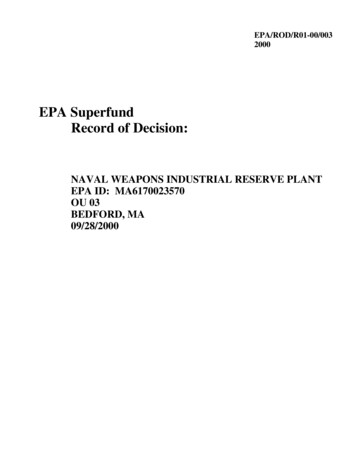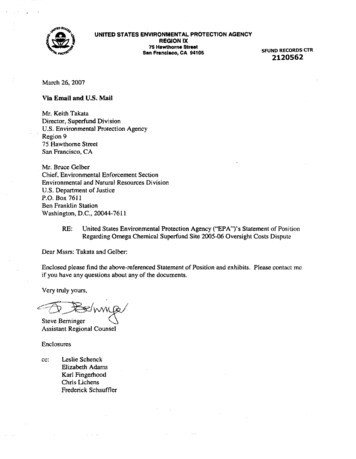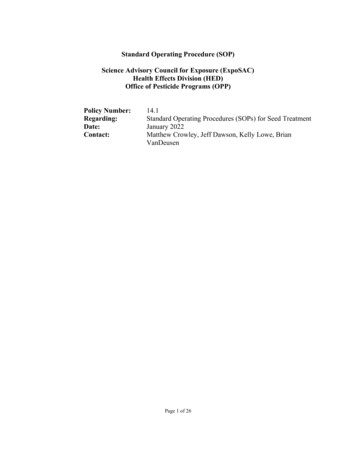
Transcription
Standard Operating Procedure (SOP)Science Advisory Council for Exposure (ExpoSAC)Health Effects Division (HED)Office of Pesticide Programs (OPP)Policy Number:Regarding:Date:Contact:14.1Standard Operating Procedures (SOPs) for Seed TreatmentJanuary 2022Matthew Crowley, Jeff Dawson, Kelly Lowe, BrianVanDeusenPage 1 of 26
Table of ContentsI.INTRODUCTION . 3II. SEED TREATMENT “UNIT EXPOSURES” . 7III. SEED TREATMENT SCENARIOS. 12A.Commercial Seed Treatment (CST). 13B.Loading and Planting of Commercially Treated Seed (LPTS) . 16C.On-Farm Seed Treatment and Planting of Treated Seeds with Liquid Formulations(OFST/P-L). 17D.On-Farm Seed Treatment and Planting of Treated Seeds with Solid Formulations(OFST/P-S) . 20Appendix A. Summary of Studies in Included in Policy 14. 23Appendix B. Summary of Seed Treating Equipment Used in Studies . 26Page 2 of 26
I.INTRODUCTIONTreated seed is defined as seed that is given an application of pesticide to reduce, control or repeldisease organisms, insects, or other pests that attack seed. This definition includes control ofpests while the seed is in storage and after planting. Seeds commonly treated are corn, smallgrains or cereals (barley, oats, rye, wheat, and rice), sorghum, millets, soybeans, sugar beets,sunflowers, cotton, and flax; however, seeds for other crops (e.g., vegetable seeds) are alsotreated and are covered by this policy. Seed treatment pesticides are applied as either dusts,slurries, or liquids.The potential for exposure from seed treatment can be divided into two main categories: treatingseed and loading/planting treated seed. Within the treating seed category, potential exposurescenarios can include mixing, loading, applying formulations; packaging of treated seed (forcommercial seed treatment only); and other activities, such as cleaning and calibrating treatmentequipment. Within the loading/planting treated seed category, potential exposure includesloading of the treated seed into the planter and planting of the treated seed.This seed treatment standard operation procedure (SOP) contains all known scenarios associatedwith commercial and on-farm seed treatment, as well as planting of treated seed. It is importantto note what scenarios and activities are not covered by this policy. Specifically, certain cropsare not produced from seed, for example nursery and floriculture production. Similarly, certainperennial crops are not grown from seed, like trees and shrubs. The assessment ofloading/planting seed only pertains to treated seed and does not cover treating or plantingtransplants.There are multiple venues for treating seeds, including large commercial companies, smallerdownstream companies, and local on-farm businesses. Commercial seed treatment companiesare seed producers that own or license their own seed lines and provide seed enhancementservices in addition to seed treatment. Downstream seed treatment companies obtain cleanedand ready-for-planting processed seed from other sources such as seed producers and growers.These companies include retailers, distributors, and agricultural cooperatives. On-farmbusinesses treat batches locally on a per order basis. For additional clarification and definitionsof the various terminologies used in seed treatment practices, see the glossary in ExpoSACPolicy 15.Commercial seed treatment can involve three different seed treater types:1. Continuous flow treaters which treat a steady flow of untreated seed with the seedtreatment product (photos copied from AHETF 2014 1)1 Agricultural Handler Exposure Scenario Monograph for Commercial Seed Treatment Scenarios. Report Number AHE1008.March 2014.Page 3 of 26
-iJfcontinuous Flow Seed - Seed eatmentApplication and MixingAtomizer for initial ee dtr,eatment appJfo ati on to se e,dSpray Nozzl e Atomi:zati·o nMixing systems for e : on dal)' m.i xingAuger / M ix ing fing er mixingDnunmixing2. Batch treaters which treat a single batch (or given amount of seed) at a time (photoscopied from AHETF 20141)Batch Treaters" U"Trough batch mixer"U" Trough batch mkerSee d holdin g h imSimpl e batch mi xers3. Continuous batch treaters which are a combination of a continuous flow and a batchtreater, utilizing seed from a steady flow of untreated seed, and treating the seed inbatches until the seed source is depleted or a predetermined number of batches are treated(photos copied from AHETF 20141)Page 4 of 26
Continuous Batch Treating SystemsTypi cal CB treater' iklas & Gustafs o n CB TreaterIn commercial seed treatment facilities, seed is professionally treated and packaged in smallbags, mini-bulk containers (e.g., bins or large bags), or loose bulk containers (e.g., seed wagonsor trucks), and then delivered later to growers (photos copied from AHETF 2014 2).Example of Bagged Seed;l.· -ifxamplesof Bulk Seed Boxes and Bags' il f! '1lII-,I---- -:,,,-2 Agricultural Handler Exposure Scenario Monograph for Commercial Seed Treatment Scenarios. Report Number AHE1008.March 2014.Page 5 of 26
ose B ul Storage Con1ainers and conveying systemsBins with Elevator LegBucket ElevatorBins with auger '1 Ton Bulk Bag & BoxSeed TruckSeed"\ VagonDownstream facilities process much of their seed as loose bulk, where treated seed is conveyedinto a grower's truck or wagon directly from the treater. This is distinctly different from on-farmseed treating where seed is treated on-site and planted without bagging. All on-farm seedtreatment systems have a method to transfer and treat clean untreated seed from bulk storage to aseed wagon or truck, or from a truck or wagon to the planter.On-farm seed treatment generally involves workers that operate any on-farm seed treatingequipment, including mixing, loading and application of a pesticide to untreated seed, and anyassociated tasks such as maintaining the treating equipment and planting the treated seed. Thisscenario applies to any seed type labeled for on-farm seed treatment. On-farm seed treatingequipment typically involves some type of mechanical conveying or augering system thataccommodates treatment as the seed is moved into equipment such as a seed truck (such as fortransport to the field), onto a conveyor (such as for transport into temporary storage), or directlyinto a planter. All on-farm seed treaters are continuous flow treaters, meaning the seed treatmentprocess continues until the seed supply is depleted. On-farm systems are manual in design andrequire an operator to stop and start the seed treating process (photos copied from AHETF2014 3).3 Agricultural Handler Exposure Scenario Monograph for Commercial Seed Treatment Scenarios. Report Number AHE1008.March 2014.Page 6 of 26
Seed Treatment with SeedFillingSmall Grain PlantersAuger Mixing[The Small Grain Transfer AugerFor commercial seed treatment, depending on seed type, exposure duration may vary betweenshort- and intermediate-term (i.e., up to 6 months of exposure). For on-farm seed treatment, theexposure duration is anticipated to be short-term only (i.e., up to 30 days of exposure).II.SEED TREATMENT “UNIT EXPOSURES”The data contained in this document are for worker exposure estimation, were generated by thepesticide industry, and were primarily submitted by the Agricultural Handler Exposure TaskForce (AHETF). Exposure estimates are from studies monitoring workers during actual seedtreatment and are based on physical factors of a handler scenario (e.g., commercial seedtreatment, on-farm seed treatment, planters, etc.). “Unit exposures” have been developed fromthese data sources for seed treatment scenarios and are typically expressed as mass of pesticideactive ingredient exposure per unit mass of active ingredient handled (e.g., µg/lb ai). The Agencythen uses these unit exposures “generically,” irrespective of chemical identity, to estimatePage 7 of 26
exposure for other seed treatment pesticides.This revised SOP is primarily based on four submissions from the AHETF: The AHETF Monograph for Commercial Seed Treatment (CST) (Bruce and Holden,2014) provides a summary of eleven studies (conducted between 2000 and 2010)supporting the commercial seed treatment scenario and reflects potential for workerexposure from activities such as treating seed, packaging treated seed, and cleanout oftreatment equipment. The AHETF Monograph for Loading and Planting Treated Seed (LPTS) (Standart andHolden, 2014) provides a summary of two studies (conducted in 2007 and 2008)supporting the loader/planter scenario and reflects potential for worker exposure fromtasks commonly performed during loading of commercially treated seed and subsequentplanting of the seed using planting equipment with enclosed cabs. The AHETF Monograph for On-Farm Seed Treatment and Planting with Liquids(OFST/P-L) (Standart and Holden, 2014) provides a summary of three studies (conductedin 1999 and 2006) supporting the on-farm seed treatment with liquid formulationsscenario and reflects potential for worker exposure from mixing, loading and applying aliquid pesticide to seeds using on-farm equipment, including any associated tasks such asmaintaining the treating equipment, and planting the treated seed. The AHETF Monograph for On-Farm Seed Treatment and Planting with Solids(OFST/P-S) (Klonne and Holden, 2008) provides a summary of one study (conducted in2005) supporting the on-farm seed treatment with solid formulations scenarios andreflects potential for worker exposure from loading/applying a solid/dust pesticide toseeds using on-farm equipment, including any associated tasks such as maintaining thetreating equipment and planting of the treated seed.All of the studies and monographs included in the AHETF submissions were reviewed by EPAand considered acceptable. In addition to the AHETF submitted studies, EPA also chose toinclude one additional study in the CST dataset 4. This study was completed in 2014 (after thestudies included in the AHETF submission), was reviewed separately by EPA and consideredacceptable. A list of the included studies is provided in Appendix A. EPA’s monograph reviewsalso identify other studies that were considered by either the AHETF and/or EPA for inclusion inthe datasets but were ultimately excluded for various reasons.As opposed to the OFST and LPTS datasets, where the monitored workers all performed thesame activities, workers in the CST dataset conducted various activities and were groupedaccording to the activities they performed. Each monitored worker was assigned one of sevenactivity patterns, based on common CST tasks performed. The activity pattern classificationswere treat (T), package (P), cleanout (C), treat/package (TP), treat/cleanout (TC),package/cleanout (PC), and treat/package/cleanout (TPC). In the AHETF CST monograph, theseworker activities were grouped into three proposed scenarios: (1) CST-TM - treating/multipleEPA MRID 49421402 (Lange, 2014). Abamectin/Thiamethoxam Observational Study to Determine Dermal and InhalationExposure of Workers in Commercial Seed Treatment Facilities to Abamectin During Cotton Seed Treating and EquipmentCleaning Activities Final ReportPage 8 of 264
activities (which includes the following work activity assignments: T, TC, TP, and PC) 5, (2)CST-P - packaging (includes P only), and (3) CST-C - cleaning (includes C only). EPA agreedwith the proposed worker scenarios with one small change. While the treater/multiple activityscenario covers activities other than treating (including some packaging and cleaning), EPA isproposing that this scenario be referred to as simply the “treating” scenario and that risk concernsbe addressed only relative to treating activities, since packaging and cleaning would be addressedby the other two scenarios.The summary tables below provide the dermal and inhalation unit exposures with different typesof personal protective equipment (PPE) for activities related to seed treatment and plantingtreated seed. Table 1 provides unit exposures for commercial seed treatment, Table 2 provides unit exposures for loader/planters of commercially treated seed, Table 3 provides unit exposures for on-farm seed treatment and planting of seeds usingliquid formulations, and Table 4 provides unit exposures for on-farm seed treatment and planting of seed usingsolid/dust formulations.A few items of note related to the unit exposures for these scenarios and implications for riskassessment:Commercial Seed Treatment scenarios In the AHETF submission, workers involved in loading of a chemical into a treater allused closed systems. There are no data available for use of open loading commercialseed treatment systems. The AHETF’s proposal is that the CST dataset be used torepresent closed loading systems only. They suggest that open pour loading for seedtreatment could be conservatively estimated using data for workers conducting routineopen pour loading of liquids in agricultural settings. However, those unit exposures arenumerically very close or lower than the EPA-proposed closed loading seed treatmentunit exposures based on the new dataset. While exposure may be expected to be higherwith use of an open loading system, the impact of a closed versus open loading system ontotal exposure for treaters is not straightforward because workers did other activitiesbeyond just loading of the chemical (e.g., calibrating treater, treating/coating seed,sampling “wet” treated seed). Therefore, EPA agrees with the AHETF that the CSTdataset will only represent closed loading systems; however, EPA will not quantifyexposure from the use of an open loading system using the available agricultural openloading unit exposures but may include characterization in the risk assessment around thepotential impact on exposure from the use of open loading systems. For purposes of risk management, the recommendation is that any risk concerns based onthe treating dataset should be addressed relative to treating seed (i.e., mixing and loadingchemical, calibrating the treater, treating/coating the seed and sampling “wet” treatedTPC would also have been included in this scenario, however, there were no monitoring units identified as having conductedthis activity category.Page 9 of 265
seed), and risk management of any risk concerns for packaging treated seed or cleaningseed treatment equipment be based on the assessment for those exclusive activities.Since the CST scenario represents commercial seed treatment only, for risk assessmentpurposes, it would be paired with the LPTS scenario. The OFST/P scenarios (both liquidand solid) represent both on-farm seed treatment and planting of treated seed and wouldbe stand-alone scenarios.For the cleaning scenario, the unit exposure is expressed in terms of the application rateand activity duration rather than an absolute amount of chemical handled. After reviewof the monitoring times reported for this activity in the studies, a default activity durationof 2.5 hours is proposed for use in the calculation of exposure for clean-out activities.Loading/Planting Treated Seed scenario Exposure to workers’ hands was monitored separately during loading of the treated seedand while planting the treated seed; therefore, unit exposures were able to be calculatedfor both “no gloves” and “gloves” for each of those activities. While the data wereavailable to calculate these different options, for the purposes of risk mitigation, thepolicy only provides unit exposures assuming a worker is wearing gloves while bothloading and planting treated seed or assuming a worker is not wearing gloves while bothloading and planting treated seed. The additional combinations (e.g., wearing gloveswhile loading but not while planting) are available in the LPTS monograph (D460313). For the planters, it is assumed that there is no difference in exposure between open versusclosed cabs based on the likelihood that most worker exposure while planting treatedseeds is coming from activities occurring outside the planter/tractor cab (i.e., maintenanceactivities).On-Farm Seed Treatment and Planting (solids and liquids) scenarios: The AHETF intended for this scenario to cover both open and closed loading systems.Out of the 48 monitoring units (MUs) monitored during chemical loading procedures,two of them (both from the same study) involved a closed loading system. EPA hasdecided that due to the limited data representing closed loading systems, the OFST/P-Ldataset will be used to represent open loading systems only. While exposure may beexpected to be lower with use of a closed loading system, the impact of a closed versusopen loading system on total exposure is not straightforward because workers did otheractivities beyond just loading chemical (e.g., loading treated seed into planters andplanting treated seed). EPA did consider the use of unit exposures for closed loading ofliquids in agricultural settings; however, those values are much lower than would beexpected if on-farm seed treatment was conducted using closed loading. Therefore, EPAproposes that the OFST/P-L dataset will only represent open loading systems. EPA willnot quantify exposure from the use of a closed loading system but may includecharacterization in the risk assessment around the potential impact on exposure from theuse of closed loading systems. For OFST/P-L, the unit exposures are intended to cover any kind of on-farm seedtreatment and planting equipment appropriate for the job using liquid formulations orformulations applied as liquids (e.g., wettable powders and dry flowables).Page 10 of 26
For OFST/P-S, the unit exposures are representative of solid/dust formulationapplications via hopper box but will be used as surrogate data for the use of other similarequipment used on-farm with solid/dust formulations.Table 1. Summary of Commercial Seed Treatment (CST) Unit Exposure Values.TypeExposure gingDermalInhalationDermal349Single layer/gloves51.2InhalationMean42.2No Respirator1.2PF100.12Single layer/no gloves68Single layer/gloves16.9Mean13.1No Respirator3.6PF100.36Single layer/no gloves138,210,600Single layer/gloves23,262,800Double layer/glovesAll FormulationsUnit Exposure(ug/lb ai, except for cleaners: (µgai/hr)/(lb ai/lb seed))Single layer/no glovesDouble layer/glovesAll FormulationsCleaningStatisticDouble layer/glovesAll FormulationsCommercialSeed Treatment(CST)PPEMean21,238,200No Respirator106,100PF1010,610Table 2. Summary of Loading/Planting of Commercially Treated Seed (LPTS) Unit Exposure Values.TypeLoader/PlantersExposure ScenarioLoading/Planting TreatedSeed (LPTS)ExposureRoutePPESingle layerDermalAll FormulationsDouble layerInhalationLoader: NoGlovesPlanter:No GlovesLoader:GlovesPlanter: GlovesLoader:GlovesPlanter: GlovesNo RespiratorPage 11 of 26StatisticUnit Exposure(ug/lb ai)3,994797Mean53066
Table 2. Summary of Loading/Planting of Commercially Treated Seed (LPTS) Unit Exposure Values.TypeExposureRouteExposure ScenarioPPEStatisticUnit Exposure(ug/lb ai)PF106.6Table 3. Summary of On-Farm Seed Treatment and Planting using Liquid Formulation (OFST/P-L) Unit Exposure Values.TypeOn-Farm SeedTreatmentExposure ScenarioExposure RoutePPEDermalOn-Farm Seed Treatment/Planting with Liquids*(OFST/P-L)StatisticUnit Exposure(ug/lb ai)Single layer/no gloves1094Single layer/gloves226Double layer/glovesInhalationMean186No Respirator37.1PF103.71* Liquid formulations and formulations applied as liquids (e.g., wettable powders and dry flowables)Table 4. Summary of On-Farm Seed Treatment and Planting using Solid (Dust) Formulation (OFST/P-S) Unit Exposure Values.TypeOn-Farm SeedTreatmentExposureRouteExposure ScenarioOn-Farm Seed Treatment/Planting with Solids*(OFST/P-S)DermalPPEStatisticUnit Exposure(ug/lb ai)Single layer/no gloves27,887Single layer/gloves7,574Double layer/glovesInhalationMean5,532No Respirator633PF1063.3*Solid and dust formulationsIII.SEED TREATMENT SCENARIOSThe following sections provide an overview of the various seed treatment scenarios. A moredetailed description of the scenarios and the underlying data can be found in the accompanyingmonograph and study reviews noted below.Table 5. Summary of Supporting Documents for Policy 14ScenarioCommercial Seed Treatment (CST)Loading/Planting of Commercially Treated Seed (LPTS)On-Farm Seed Treatment and Planting of Seeds treated with LiquidFormulations (OFST/P-L)Page 12 of 26Monograph (EPAReview Code)D460312D419699Study (EPAReview Code)D419699D460311D419862D460310
Table 5. Summary of Supporting Documents for Policy 14ScenarioOn-Farm Seed Treatment and Planting of Seeds treated with SolidFormulations (OFST/P-S)A.Monograph (EPAReview Code)Study (EPAReview Code)D460314D392522Commercial Seed Treatment (CST)Eleven studies support the CST scenario and provide a summary of the potential dermal andinhalation exposure for workers conducting activities related to commercial seed treatmentincluding treating seed, packaging treated seed, and cleanout of the equipment. The studiesmonitored dermal and inhalation exposure to workers at 57 facilities located in Great Britain,Germany, Canada, France, and the United States between 2000 and 2014. In total, there were423 monitoring units included in this dataset. In all studies, a liquid seed treatment formulationwas used. Overall, 11 different active ingredients were monitored. Seed treatment equipmentvaried across sites and included both continuous flow, continuous batch, and single batchtreaters. Examples of specific types of commercial seed treatment equipment used in the studiesunderlying the seed treatment exposure data are provided in Appendix B. Treated seed waspackaged into small bags, mini-bulk containers, and/or loose bulk storage containers usingbagging/closing and stacking systems ranging from manual to automated levels of operation. Thetypes of seed treated included oilseed, corn, small grain, and cotton.The tasks monitored included those associated with treating the seed (i.e., operating the treatingequipment, loading the chemical, or calibrating the treating equipment), packaging the treatedseed (i.e., bagging, closing, tagging, stacking, or forklifting), and cleanout of the treatmentchamber. Tasks not involving direct contact with the test substance were also routinelyperformed during the monitoring time, such as daily maintenance (i.e., sweeping, cleaning,vacuuming) and loading of untreated seed. Each monitoring unit was assigned one of sevenactivity patterns, based on the tasks performed. The activity pattern classifications are treat (T),package (P), cleanout (C), treat/package (TP), treat/cleanout (TC), package/cleanout (PC), andtreat/package/cleanout (TPC). For the CST unit exposure dataset, the worker activities describedabove were grouped into three scenarios: (1) Treating (which includes the following workactivity assignments: T, TC, TP, and PC) 6, (2) Packaging (includes P only), and (3) Cleaning(includes C only).For the most part, it is anticipated that worker exposure for an entire CST workday could bedescribed using either the treating or packaging scenarios. The packaging scenario was includedbecause workdays devoted exclusively to packaging tasks are expected to be common in manyCST facilities. Workdays devoted entirely to cleanout are thought to be infrequent. It is morelikely that cleanout tasks would be of shorter duration and mixed with other chemical handlingtasks during the same workday which would be covered by the treating scenario. However,cleanout of seed treating equipment is a task that can involve intensive contact with6 TPC would also have been included in this scenario, however, there were no monitoring units identified as having conductedthis activity category.Page 13 of 26
contaminated surfaces and often involves workers wearing extra PPE, such as Tyvek clothing.Therefore, this scenario was kept separate in order to provide the ability to determine exposureand risk mitigation for those particular workers.CST-Treating:The CST-Treating scenario represents any possible CST workday during which CST workerexposure is the result of performing any combination of packaging, treating, or cleanout tasks,but not exclusively packaging or exclusively cleanout. This scenario includes several tasks thatare very critical to the CST process and generally involve just a few specially trained workers ateach facility, including mixing and loading chemical, calibrating the treater, treating/coating theseed and sampling “wet” treated seed. Worker-day exposure associated with these scenariospecific tasks is expressed relative to the amount of active ingredient handled (AaiH).All of the MUs included in the overall dataset conducted loading using closed systems (examplesin Figure 1). Five workers from one study and four workers from another study were rejected forusing open pour methods in the mixing/loading procedures. The AHETF rejected thesemonitoring units because of an insufficient number and diversity of replicates to characterize theimpact of open-pour on the exposure to multiple-activity scenarios. The AHETF suggested thatopen pour could be conservatively estimated using open pour liquid M/L scenario data; however,those unit exposures are numerically very close or lower than the EPA proposed closed loadingseed treatment unit exposures based on the new dataset. While exposure may be expected to behigher with use of an open loading system, the impact of a closed versus open loading system ontotal exposure for treaters is not straightforward because workers did other activities beyond justloading of the chemical (e.g., calibrating treater, treating/coating seed, sampling “wet” treatedseed). Therefore, EPA agrees with the AHETF that the CST dataset will only represent closedloading systems; however, EPA will not quantify exposure from the use of an open loadingsystem using the available agricultural open loading unit exposures but may includecharacterization in the risk assessment around the potential impact on exposure from the use ofopen loading systems.injection from product cont.aimnDirect injection from work tanksFigure 1. Example of Closed Loading SystemsPage 14 of 26
While there were “treater-only” monitoring data, the possibility of having only those monitoringunits in the treating scenario was rejected because the available treater-only MUs wereconsidered inadequate to characterize a treating-only scenario. The exposure data representedonly six different workers in four corn seed treating facilities. No oil seed or small grainsfacilities are represented at all. Unlike packaging and cleanout where a number of monitoredworkers exclusively conducted those activities over their entire workday, it is unclear whethertreating seed should be treated as an exclusive activity. Of the 396 available data points, only 18can be categorized as “treating only”, representing only six workers. Therefore, the CSTTreating scenario conceptually represents a general CST scenario pertaining to any worker-daynot devoted exclusively to either packaging or cleanout.While the CST-Treating scenario represents workers performing activities beyond just treating ofthe seed, ultimately, for purposes of risk management, EPA recommends any risk concerns basedon the CST-Treating dataset should be addressed relative to treating seed. As noted above,“treating” involves not only loading of the chemical, but also calibration of the treater,treating/coasting the seed, and sampling “wet” treated seed. EPA feels this is appropriateconsidering that activities other than those involved in treating will be addressed by the other twoscenarios (CST-Packaging and CST-Cleaning). Risk management of any risk concerns forpackaging treated seed or cleaning seed treatment equipment will be based on the assessment forthose exclusive activities.CST-Packaging:The CST-Packaging scenario represents any possible CST workday during which CST workerexposure is the result of performing one or more packaging tasks, but none of the treating orcleanout tasks. The packaging-related tasks identified include bagging, closing/sewing, tagging,stacking, and moving packaged seed via forklift (examples shown in Figure 2). Worker-dayexposure associated with these scenario-specific tasks is expressed relative to the amount ofactive ingredient handled (AaiH).i ft for smaU bags and boxe.s nual StackingFigure 2. Examples of Packaging-related TasksCST-Cleaning:The CST-Cleaning scenario represents any possible CST workday during which CST workerexposure is the result of performing cleanout-related tasks. Cleanout of seed-treating equipmentis a task that can involve intensive contact with contaminated surfaces and often involvesworkers wearing extra PPE (such as Tyvek clothing). In the available studies, workers thatPage 15 of 26
cleaned the seed treatment equipment utilized a number of different approaches/methodsincluding scraping, wiping, brushing, compressed air, pressurized water, vacuum cleaners, etc.Cleanout tasks might occupy a worker anywhere from a few minutes up to a large portion of theworkday. The cleanout activity frequently involves intermittent cleanout tasks that occur forshort durations periodically during a workday. If such workdays involve packaging a
In commercial seed treatment facilities, seed is professionally treated and packaged in small bags, mini-bulk containers (e.g., bins or large bags), or loose bulk containers (e.g., seed wagons or trucks), and then delivered later to growers (photos copied from AHETF 2014
